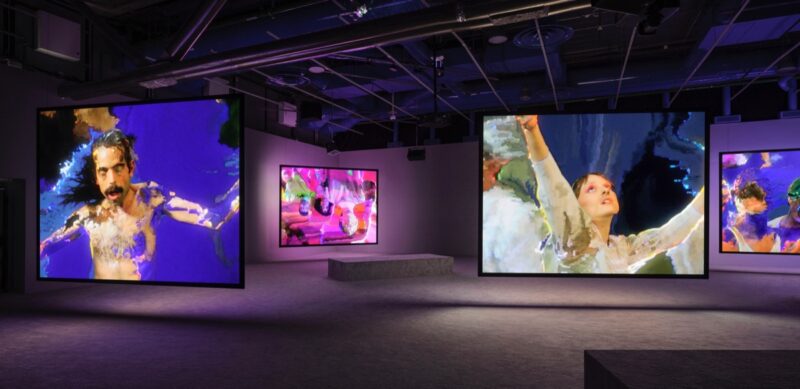[Fall 2024]
Phase Shifting Index
by Marie Perrault
[EXCERPT]
Presented first at the Centre Pompidou in Paris and the Swiss Institute in New York in 2020, Phase Shifting Index arrived in Quebec following a North American tour. In the seven-channel installation exhibited at Fonderie Darling by the Musée d’art contemporain de Montréal, Jeremy Shaw showed, on seven separate screens, groups of people engaged in ritual movements. The videos look like documentary films dating from the 1960s to the 1990s – even reproducing the clothing styles of the respective periods – on the different alternative holistic movements shown. In a pseudo-documentary register, an off-screen voice describes the gestural protocols that transform corporeal perceptions and change consciousnesses, promising the participants a heightened future life.
Under John Zeppetelli’s curation, the layout of the large gallery at Fonderie Darling, with the screens hung in a broken line, allowed viewers both to watch each individual video and to take in the whole at a glance. The floor, covered with soft carpeting, the bleachers along one of the gallery’s walls, and the seats placed between the screens induced a singular physical experience rooted in the experience of watching.
The installation was punctuated by the cacophony of the different choreographies described in each video projection, immersing spectators in the participants’ gestures, search for transcendence, and beliefs. Their respective rhythms gradually coalesce, finally melting together, with stroboscopic effects, to form a single moving image into which are inserted close-ups of the different actors, modified by datamoshing, a digital composition process that consists of deliberately introducing compression errors. The lighting effects thus obtained and the rhythm of the music swept spectators into the ambience of a rave, a type of popular gathering that somehow echoes the initiation rituals shown before.
For twenty years, Shaw has been exploring different protocols employed in the search for sublimation, notably the use of hallucinogens, dance, group breathing exercises, religious prayer, and spiritual practices, all of which prove to be preparations for a secular enlightenment based on out-of-body experiences. Through the spectacular visual means of Phase Shifting Index, this approach highlights such eminently metaphysical questions as surpassing oneself, the dissolution of bodily boundaries, and reaching an elsewhere or beyond within the self, as well as underlying belief systems. The commentary integrated into the pseudodocumentaries also contrasts the fervour to which the videos attest against the objective description of the gestural rituals that we see, sometimes imparted in language related to the cognitive sciences. In this sense, the work constitutes almost a social-anthropology treatise both about such belief systems and about the documentary or scientific rationality that attempts to explain them.
The evolution of the different projections toward their synchronized amalgamation installation-wide transformed the gallery and our perception of the work into an ultimate fieldwork site. This dénouement referred us to our own experience as subjects in the gallery space, a notion reinforced by the unique nature of Fonderie Darling’s formerly industrial space. The propaedeutic exercises “documented” here resemble common physical activities such as yoga and working out, aimed at achieving a fantasy body or self-improvement through mindfulness. The limit states of these rituals serve, in short, to engage a more general reflection on the human condition, as their extreme nature – even eccentricity – evokes quests for transcendence more widespread than those actually shown. For my part, I saw a metaphor for the artistic experience, including the search for the ideal, the communion among individuals, and the self-surpassing that characterizes it.
In the context of Fonderie Darling, the critique and the discourse on art corresponded to the offerings of the pseudo-documentary audio in the first part of the work. It was a pleasure to be caught up as a protagonist in the spectacular maelstrom and to experience, in a way, the same secular enlightenment. Translated by Käthe Roth
[ Complete issue, in print and digital version, available here: Ciel variable 127 – SISTERS, FIGHTERS, QUEENS ] [ Complete article in digital version available here: Phase Shifting Index]



